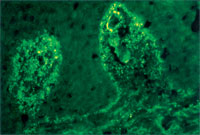
When are special tests necessary to diagnose blistering diseases of the skin? | ||||||||||||||||||||||||||||||||||||||||||||||||||||||||||||||||||||||||||||||||||||||||||||||||||||||||||||
| Table 10-4. Direct Immunofluorescence Findings of Vesiculobullous Diseases | |||||
| DISEASE | TARGET ANTIGEN | DIRECT IMMUNOFLUORESCENCE FINDINGS | |||
Bullous pemphigoid | BP180, BP230 | Linear C3, IgG at DEJ | |||
Bullous SLE | COL7A1 | Linear/granular IgG, other Igs at DEJ | |||
Cicatricial pemphigoid | BP180, LAM5, and others | Linear C3, IgG, IgA at DEJ | |||
Dermatitis herpetiformis | eTG | Granular IgA, C3 in upper dermis (see Fig. 10-1) | |||
Epidermolysis bullosa acquisita | COL7A1 | Linear IgG, IgA, other Igs at DEJ | |||
Herpes gestationis | BP180 | Linear C3, IgG at DEJ | |||
Linear IgA bullous dermatosis | BP180, COL7A1, LAD | Linear IgA, C3 at DEJ | |||
Pemphigus foliaceus | DSG1 | IgG, C3 in intercellular spaces | |||
Pemphigus vulgaris | DSG3 (mucous membrane only) DSG3 and DSG1 (mucous membrane and skin) | IgG, C3 in intercellular spaces | |||
IgA pemphigus | DSC1, DSG1, DSG3 | IgA in intercellular spaces | |||
Paraneoplastic pemphigus | DSG1, DSG3, DP1, DP2, BP180, BP230, EP, PP, γ-catenin, plectin, 170 kD, DSC2, DSC3 | IgG, C3 in intercellular spaces, DEJ | |||
Porphyria cutanea tarda | None (not antibody mediated) | Homogenous IgG at DEJ and around vessels | |||
Anti–p200 pemphigoid | 200-kD antigen | IgG, C3 at DEJ | |||
Anti–p105 pemphigoid | 105-kD antigen | IgG, C3 at DEJ | |||
| DEJ, Dermal–epidermal junction; Ig, immunoglobulin; C3, third complement component. | |||||
© 2024 Skin Disease & Care | All Rights Reserved.